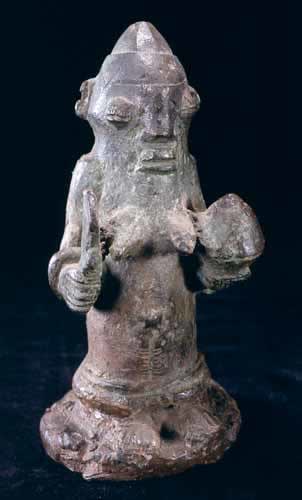Yoruba Bronze Ogboni Sculpture of a Woman, 1600 CE - 1800 CE
Bronze
3 x 6.375
PF.4745 (LSO)
This is an attractive and significant piece of African art. The small flat-based brass figure of a standing woman was made by the Yoruba of Nigeria. It is a well-constructed,...
This is an attractive and significant piece of African art. The small flat-based brass figure of a standing woman was made by the Yoruba of Nigeria. It is a well-constructed, with an elongated torso (truncated just below the navel for the ringed pedestal base), prominent breasts and a powerful face that blends in with the chest without constriction for the neck. The head is evidently helmeted, the wrists decorated with bangles. The figure is holding what appear to be a ceramic vessel and a club/sceptre/weapon. The figure is very heavy and has an uneven patination combined with considerable use wear.
The Yoruba are a Central Nigerian tribal group, originally descended from a Hausa migration from the northeast in about 900 AD. A small kingdom – Ile Ife – was founded by Oduduwa, followed by great sociopolitical expansion into Southwest Nigeria, Benin, and Togo. Communities were presided over by the Oba (king) and various senates (Ogboni), and councils made up of guild leaders, merchants and the lesser aristocracy (related to the Oba). The Yoruba have an exceptionally rich and diverse mythology, history and religious context, all of which are directly linked to their artistic output.
Ogboni is a Yoruban institution that exercises social, judicial and sociopolitical power over the populace and even exercises control over regents in local monarchies. They are gerontocratic, generally benign, and focused upon the veneration of the earth (Ile or Odua). Membership of the Ogboni is a major indicator of status in Yoruba society, and this status is reinforced through the commissioning of religious and courtly paraphernalia. Most Ogboni pieces – which include jewellery and sculptures –are made of brass/copper, the non-rusting character of which is viewed as a metaphor for immortal functions and beliefs of the members. Perhaps the best known Ogboni symbol is the initiates or “edan” figures, a pair of naked male and female figures that are worn around the neck on a chain.
This may have once been half of a pair - many Ogboni sculptures are male/female to reiterate ancient ancestry and harmony. The small scale of this piece indicates it was a personal or domestic rather than institutional object.
The Yoruba are a Central Nigerian tribal group, originally descended from a Hausa migration from the northeast in about 900 AD. A small kingdom – Ile Ife – was founded by Oduduwa, followed by great sociopolitical expansion into Southwest Nigeria, Benin, and Togo. Communities were presided over by the Oba (king) and various senates (Ogboni), and councils made up of guild leaders, merchants and the lesser aristocracy (related to the Oba). The Yoruba have an exceptionally rich and diverse mythology, history and religious context, all of which are directly linked to their artistic output.
Ogboni is a Yoruban institution that exercises social, judicial and sociopolitical power over the populace and even exercises control over regents in local monarchies. They are gerontocratic, generally benign, and focused upon the veneration of the earth (Ile or Odua). Membership of the Ogboni is a major indicator of status in Yoruba society, and this status is reinforced through the commissioning of religious and courtly paraphernalia. Most Ogboni pieces – which include jewellery and sculptures –are made of brass/copper, the non-rusting character of which is viewed as a metaphor for immortal functions and beliefs of the members. Perhaps the best known Ogboni symbol is the initiates or “edan” figures, a pair of naked male and female figures that are worn around the neck on a chain.
This may have once been half of a pair - many Ogboni sculptures are male/female to reiterate ancient ancestry and harmony. The small scale of this piece indicates it was a personal or domestic rather than institutional object.



